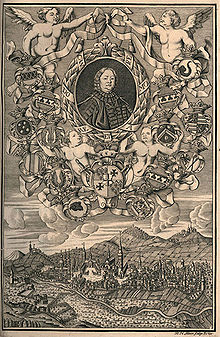Prince-abbot
 From Wikipedia the free encyclopedia
From Wikipedia the free encyclopedia
This article has multiple issues. Please help improve it or discuss these issues on the talk page. (Learn how and when to remove these messages)
|

In the Holy Roman Empire, a prince-abbot (German: Fürstabt) was the cleric who headed a princely abbey. The prince-abbot had a seat and an individual vote (votum virile) in the Imperial Diet alongside the prince-bishops. They ranked higher than the imperial abbots and imperial abbesses who although they were also immediate, held only two collective votes in the Diet.
Actual prince-abbots were:
- the Abbot of Fulda, "Archchancellor of the Empress", according to a 1220 decree by Emperor Frederick II, elevated to a Prince-Bishopric by Pope Benedict XIV in 1752[1]
- the Abbot of Prüm, elevated by Emperor Frederick II in 1222, held in personal union by the Archbishop of Trier from 1576
- the Abbot of Kempten, confirmed by King Charles IV in 1348
- the Abbot of Murbach, elevated by King Ferdinand I in 1548
- the Prince Abbot of Saint Gall, elevated by King Philip of Germany in 1207
- the Abbot of Stavelot-Malmedy
- the Abbot of Corvey, elevated to a Prince-Bishop in 1792
- the Princess-Abbess of Quedlinburg
- the Princess-Abesses of the Imperial and Royal Theresian Stift for Noble Ladies in the Castle of Prague
See also
[edit]References
[edit]- ^ Heiler, Thomas. "Fulda, Fürstabtei: Politische Geschichte (Spätmittelalter)". Historisches Lexikon Bayerns. Retrieved January 25, 2024.